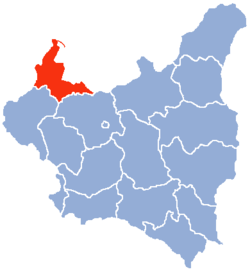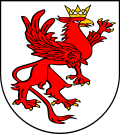Pomeranian Voivodeship (1919–39)
| Pomeranian Voivodeship Województwo Pomorskie | |||||
| Voivodeship of the Second Polish Republic | |||||
| |||||
|
Coat of arms | |||||
 within the Second Polish Republic (1938). | |||||
| Capital | Toruń | ||||
| Historical era | Interwar period | ||||
| - | Established | 1919 | |||
| - | Disestablished | 1939 | |||
The Pomeranian Voivodeship or Pomorskie Voivodeship (Polish: Województwo Pomorskie) was an administrative unit of inter-war Poland (from 1919–1939). It ceased to exist in September 1939, following the German and Soviet invasion of Poland.
Most of its territory became part of current Kuyavian-Pomeranian Voivodeship, which has the same capital (Toruń) of the interwar voivodeship.
The name Pomerania comes from Slavic po more, which means Land at the Sea.[1]
History
This was a unit of administration and local government in the Republic of Poland (II Rzeczpospolita) established in 1919 after World War I from the majority of the Prussian province of West Prussia(made out of territories taken in Partitions of Poland which was returned to Poland. Toruń was the capital. In 1938–1939, the voivodeship extended to the south at the expense of Poznań Voivodeship and Warsaw Voivodeship, and was called Great Pomerania afterwards (see: Territorial changes of Polish Voivodeships on April 1, 1938).
During World War II, it was occupied by Nazi Germany and unilaterally annexed as Reichsgau Danzig-Westpreussen ("Reich province of Danzig-West Prussia"). Poles and Jews were classified as untermenschen by German authorities and their intended fate slavery and extermination. In 1945, the region was returned to Poland. In 1945, out of its northern territory the new voivodeship of Gdańsk was formed, including annexed territories of the Free City of Danzig and of German Prussian Province of Pomerania and German Prussian Province of East Prussia. The bulk of the old voivodeship was enlarged by annexed territories of the German Prussian Province of Pomerania and later renamed into Bydgoszcz voivodeship. In the years 1975–1998 it was reorganized into the voivodeships of Gdańsk, Elbląg, Bydgoszcz, Toruń and Włocławek.
Area and counties
Between April 1, 1938 and September 1, 1939, the Voivodeship's area was 25 683 km², and its population - 1 884 400 (according to the 1931 census). It consisted of 28 powiats (counties), 64 cities and 234 villages. Railroad density was high, with 11.4 km. per 100 km² (total length of railroads within the Voivodeship's area was 1 887 km., second in the whole country). Forests covered 26.7% of the Voivodeship, which was higher than the national average (in 1937 the average was 22.2%).
Pomorskie Voivodeship was one of the richest and best developed in interwar Poland. With numerous cities and well-developed rail, it also provided the country with access to the Baltic Sea. Only 8.3% of population was illiterate, which was much lower than the national average of 23.1% (as for 1931). Poles made up majority of population (88%). After World War I the number of Germans was 117,251 in 1926 and 107,555 in 1934.[2] As of 1931 10.1% of the populace were ethnic Germans and 1.6% Jews.
This is the list of the Pomorskie Voivodeship counties as for August 31, 1939:
- Brodnica county (area 913 km², pop. 56 300),
- city of Bydgoszcz county (area 75 km², pop. 117 200),
- Bydgoszcz county (area 1 334 km², pop. 58 100),
- Chełmno county (area 738 km², pop. 52 800),
- Chojnice county (area 1 854 km², pop. 76 900),
- city of Gdynia county (area 66 km², pop. 38 600),
- city of Grudziądz county (area 28 km², pop. 54 000),
- Grudziądz county (area 758 km², pop. 42 800),
- city of Inowrocław county (area 37 km², pop. 34 400),
- Inowrocław county (area 1 267 km², pop. 67 500),
- Kartuzy county (area 1 302 km², pop. 68 700),
- Kościerzyna county (area 1 162 km², pop. 51 700),
- Lipno county (area 1 535 km², pop. 104 500),
- Lubawa county (area 833 km², pop. 53 600),
- sea county (powiat morski), with capital in Wejherowo (area 1 281 km², pop. 79 900),
- Nieszawa county (area 1 278 km², pop. 117 900),
- Rypin county (area 1 188 km², pop. 84 900),
- Sępólno Krajeńskie county (area 681 km², pop. 31 600),
- Starogard Gdański county (area 1 127 km², pop. 71 800),
- Szubin county (area 917 km², pop. 47 800),
- Świecie county (area 1 533 km², pop. 88 000),
- Tczew county (area 716 km², pop. 67 400),
- city of Toruń county (area 59 km², pop. 61 900),
- Toruń county (area 864 km², pop. 52 300),
- Tuchola county (area 1 039 km², pop. 41 200),
- Wąbrzeźno county (area 673 km², pop. 49 900),
- Włocławek county (area 1 325 km², pop. 147 800),
- Wyrzysk county (area 1 101 km², pop. 64 900).
Main cities
Biggest cities of the Voivodeship were (data according to the 1931 Polish census):
- Bydgoszcz (pop. 117 200) - since 1938
- Toruń (pop. 61 900) - the capital
- Włocławek (pop. 56 000) - since 1938
- Grudziądz (pop. 54 000)
- Gdynia (pop. 38 600)
- Inowrocław (pop. 34 400) - since 1938
- Tczew (pop. 22 500)
- Chojnice (pop. 14 100)
German minority
According to Polish census figures the German minority in 1921 counted 18.8% of the overall population(with 175.771 Germans still remaining in Polish areas), while in 1931 it counted 9.6%(104.992 Germans remaining)[3] Other more detailed estimates below:
| County (German name in brackets)[4] |
ethnic German population (1926) | ethnic German population (1934) |
|---|---|---|
| Kościerzyna (Berent) | 6,884 | 5,974 |
| Wąbrzeźno (Briesen) | 7,615 | 7,344 |
| Chełmno (Kulm) | 7,905 | 7,673 |
| Tczew (Dirschau)/ Gniew (Mewe)/ Świecie (Schwetz) | 20,446 | 17,571 |
| Grudziądz (Graudenz, town) | 3,542 | 3,875 |
| Grudziądz (Graudenz, district) | 9,317 | 8,190 |
| Kartuzy (Karthaus) | 4,800 | 3,927 |
| Chojnice (Konitz) | 9,022 | 8,070 |
| Lubawa (Löbau) | 2,078 | 1,689 |
| Wejherowo (Neustadt)/ Puck (Putzig) | 6,556 | 6,305 |
| Starogard Gdański (Pr. Stargard) | 2,909 | 3,418 |
| Toruń (Thorn, town) | 2,255 | 2,057 |
| Toruń (Thorn, district) | 7,107 | 6,738 |
| Tuchola (Tuchel) | 3,170 | 2,861 |
| Sępólno Krajeńskie (Zempelburg) | 10,866 | 11,130 |
| Pomeranian Voivodship (total) | 117,251 | 107,555 |
Voivodes
- Stefan Łaszewski – 19 October 1919 – 2 July 1920
- Jan Brejski – 2 July 1920 – 24 March 1924
- Stanisław Wachowiak – 24 October 1924-August 1926
- Mieczysław Seydlitz – August 1926 – October 1926
- Kazimierz Młodzianowski – 12 October 1926 – 4 July 1928
- Wiktor Wrona-Lamot – 28 August 1928 – 18 November 1931
- Stefan Kirtiklis – 18 November 1931 – 14 July 1936
- Władysław Raczkiewicz – 16 July 1936 – 30 September 1939
Notes
- ↑ Der Name Pommern (po more) ist slawischer Herkunft und bedeutet so viel wie „Land am Meer“. (Pommersches Landesmuseum, German)
- ↑ Kotowski, Albert S. (1998). Polens Politik gegenüber seiner deutschen Minderheit 1919-1939 (in German). Forschungsstelle Ostmitteleuropa, University of Dortmund. p. 55. ISBN 3-447-03997-3.
- ↑ http://web.ku.edu/~eceurope/hist557/lect11.htm
- ↑ Kotowski, Albert S. (1998). Polens Politik gegenüber seiner deutschen Minderheit 1919-1939 (in German). Forschungsstelle Ostmitteleuropa, University of Dortmund. p. 55. ISBN 3-447-03997-3.
References
- Maly rocznik statystyczny 1939, Nakladem Glownego Urzedu Statystycznego, Warszawa 1939 (Concise Statistical Year-Book of Poland, Warsaw 1939).
| ||||||||||||||||
Coordinates: 53°00′41″N 18°36′25″E / 53.011288°N 18.606882°E

